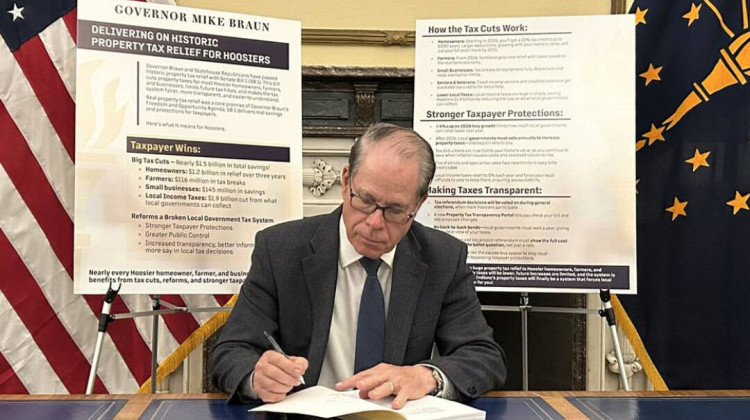
The EPA rule would require many new gas and existing coal plants to either eliminate or capture 90 percent of their carbon emissions by 2032.
Justin Hicks / IPB NewsA group of 27 states, co-led by Attorney General Todd Rokita, is suing the Environmental Protection Agency over its recent carbon reduction rule.
The EPA rule would require many new gas and existing coal plants to either eliminate or capture 90 percent of their carbon emissions by 2032. If power plants commit to retirement by 2032, they have no new emissions standards. For plants that commit to retirement by 2039, they must reduce emissions by 16 percent by 2032.
Fossil fuel advocates say the rule needs to be overhauled
Michelle Bloodworth is the president and CEO of America’s Power – an organization advocating for the nation’s coal industry.
“The carbon rule exceeds the agency's statutory authority and neglects important facts such as cost and grid reliability,” she said.
As a part of reducing carbon emissions, some plants would have to install and use carbon capture and sequestration technologies – which capture carbon emissions before they are released into the atmosphere.
Bloodworth and other fossil fuel energy advocates said this technology is too expensive and is not ready to be placed in plants across the country for mass-scale use.
She said this new requirement will jeopardize the economy and energy supplies.
“These policies, especially the new Clean Power Plan, would be a disaster for our economy,” she said. “It would jeopardize our national security. And also, send us into a reliability crisis.”
She said Indiana currently has 33 coal plants, and this rule could lead to their “premature retirement.” Bloodworth said this could severely affect Hoosier’s ability to get reliable energy.
Bloodworth said the EPA should fully rework the rule to ensure reliability and cost concerns are better addressed.
Environmental advocates emphasize the importance of rule
Andres Restrepo is a senior attorney for the Sierra Club’s environmental law program. He said the EPA rule should not have any significant reliability or cost impacts on consumers.
“That modeling does show that this is not going to lead to substantial problems in terms of, in terms of electric reliability,” he said. “It's not going to lead to increased, substantially increased, or even noticeably increased costs of electricity generation for consumers.”
READ MORE: Which Indiana communities are most vulnerable to climate change?
Join the conversation and sign up for the Indiana Two-Way. Text "Indiana" to 765-275-1120. Your comments and questions in response to our weekly text help us find the answers you need on climate solutions and climate change at ipbs.org/climatequestions.
Restrepo said there are many compliance options, including ways plants can emit less, install technology, or agree to be shut down by a certain date.
He cited a case from 2022, where the U.S. Supreme Court limited the EPA’s ability to regulate greenhouse gas emissions.
In this case, the U.S. Supreme Court said the EPA does not have the ability to force coal plants to shift to wind, solar and other cleaner fuel sources; however, the agency can issue standards to require technology and/or emission standards at power plants.
Restrepo said as a result, this new EPA requirement is still within the agency’s authority.
“What the regulations have to do is consider technologies and practices that can reduce emissions at the power plant themselves,” he said. “And that's exactly what this regulation does. I mentioned that sources will have other options beyond installing things like carbon capture and sequestration or coal-fired natural gas, but those are all simply options. Those are not requirements.”
Restrepo said many industries are already leaning less on fossil fuels, and that these changes will better align the coal industry with the future.
“A lot of these rules are really designed to accommodate the direction that a lot of industries are already going in, which is kind of recognizing that the fossil fuel-fired generation, it has less of a role to play in the future and really even now than it did even a few years ago,” he said.
He said Indiana gets 45 percent of its energy from coal-fired power plants, which is more than three times the national average. Restrepo said Indiana residents will actually benefit from these standards, as this will help to reduce pollution in areas heavily reliant on coal-fired power.
“It’s kind of really designed to help clean up those areas that are still heavily reliant upon fossil fuel-fired electricity,” Restrepo said.
Violet is our daily news reporter. Contact her at vcomberwilen@wfyi.org or follow her on Twitter at @ComberWilen.
 DONATE
DONATE






 Support WFYI. We can't do it without you.
Support WFYI. We can't do it without you.